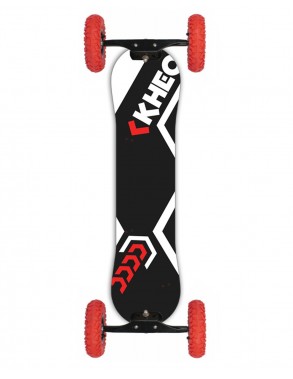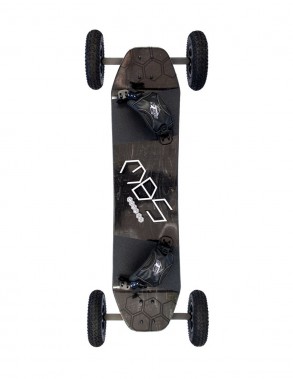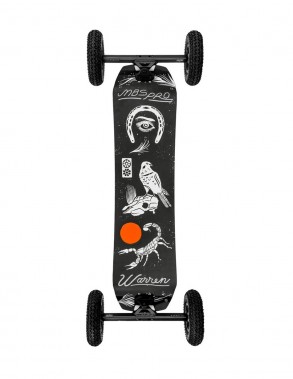Welcome to our guide to choosing your first mountainboard.
Here you'll find a summary of all the advice we give our customers in store.
There are two variations of mountainboarding, themselves divided into sub-categories: downhill mountainboarding, and landkite or towed mountainboarding. Your choice of mountainboard will be greatly influenced by the discipline you intend to practice.
To begin with, let's talk about the different disciplines and the specific features of the corresponding boards.
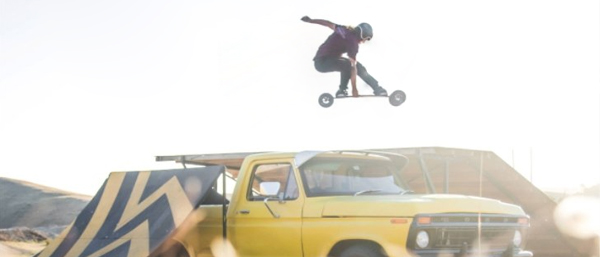
Mountainboarding: The different disciplines
- Downhill: That's how it all started: snowboarders craving snow in the summer put wheels on their boards to hurtle down the slopes of the local mountain. Downhill consists of riding downhill, at high speed, while trying not to hurt yourself!
- Board type: For an adult, the main feature of a downhill mountainboard is its trucks. In general, we prefer trucks spring-loaded boards, which are precise at high speed and very stable. The chainrings are often quite long.
- Freestyle: freestyle on a mountainboard is what you see in the videos for the big energy drink brands! Huge modules, ramps, kickers and a mountainboarder sending backflips 5m high. Visit freestyle at park, or simply make a good old-fashioned earth bump.
- Board type: Similar to downhill mountainboards, a little shorter and with trucks springs. What's important here is deck construction to give you enough pop and flex to send tricks and land them in comfort.
- Landkite : Or kite-mountainboard. This is a mountainboard towed by a traction kite or kite. Practised on the flat, often at the beach or in a field. Landkiting can take different forms: speed, cruising or freestyle.
- Board type: Depending on the discipline, all kinds of boards can be used. In landkiting freestyle, for example, light, maneuverable mountainboards with pop are preferred. In speed or cruising, for adult riders, downhill boards are preferred, with trucks springs and greater comfort.
- Wing: Wing is like landkite, a towed sport, but instead of using a kite, you use a Wing. Practices are also similar, although the Wing is best suited to cruising and speed.
- Board type: Same debate as for kitesurfing. Depending on your size, your needs will change. A grown man who wants to tack at high speed will opt for a board with trucks springs and good comfort bindings. A teenager who wants to try a bit of everything and jump will prefer a light, easy-to-handle board, with trucks skate type bindings.

Mountainboarding: The trucks
As we saw above, the choice of trucks will greatly influence the behavior and program of the mountainboard.
So let's take a closer look at the two main families of trucks mountainboards available to you.
trucks skate : as their name suggests, they resemble trucks from skateboard. Simple geometry with a single axle fitted with rubber. The trucks are light and easy to handle.
Logically, then, they're ideal for lightweight riders and those who want to be very mobile. This is the case for kite freestylers who want to be able to catch a mistake when landing a trick, and benefit from the lightest possible set-up.
Downhill, they are not recommended, as they tend to "guide" at high speed.
They are available with 10 and 12mm diameter axles. Adults will always opt for a 12mm axle for greater robustness.
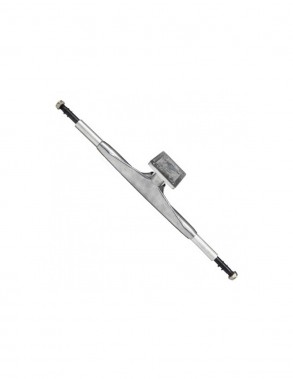
trucks springs: also known as "Channel trucks". While there are different technologies (classic springs or shockblocks on the MBS Matrix), the principle is the same: for maximum stability and control, the hanger rests on two axles fitted with springs, rubber or both.
The trucks springs are therefore "stiffer" and not at all suited to featherweights. On the other hand, at high speeds (whether kiting or downhill), they are much more comfortable and precise, making it easier to control your curves.
For longer rides, whether kiting or winging, they require less effort, especially for heavier riders who appreciate their stability.
For an electric mountainboard, this is the default choice.

Mountainboard: other equipment
Apart from trucks, a mountainboard is equipped with a chainring, wheels and bindings. Let's take a look at the different options available.
Let's start with the chainring . It's all about size and construction.
There's no need to get hung up on deck dimensions; the size is always adapted to the board's program. For example, a children's mountainboard is always small. A downhill mountainboard is always long.
Construction can vary greatly from model to model. Of course, top-of-the-range mountainboards benefit from better construction than entry-level models. These boards often feature maple-based wood construction. The higher up the range you go, the more different materials will be used in the board. So, on a high-end freestyle board, you'll find constructions similar to snowboard boards: wood core + resin + fiberglass, for example.
When it comes to wheels, the main choice is diameter.
Most boards come with 8-inch wheels. This is the standard mountainboard size for all uses. However, some models come with a choice of 9-inch (or 9") wheels. If you're going to be riding on rough terrain, it's a good idea to opt for larger wheels. This is the case if your spot consists of soft sand or a meadow full of pebbles!
Last but not least, bindings fall into two categories: Velcro or ratchet.
If you opt for a complete mountainboard, the type of bindings (or straps) will depend on your budget. Velcro bindings are always less expensive than ratchet bindings. But they're stronger because they're much simpler, and there are virtually no breakable parts. Ratchet fasteners are more sophisticated, and also more fragile, but above all ratchets offer greater comfort and adjustability.
Choosing my mountainboard model
To sum up, we can create categories of boards adapted to each discipline. Let's look at a few examples:
Example 1:"I'm an adult weighing 75 kg, and I'm starting downhill with the aim of hitting the mountain trails when I've progressed. If I find a bump, I'll try a small jump."
Opt straight away for a real Downhill model: spring-loaded trucks and a fairly long chainring. Depending on your budget, you can choose one of the following mountainboards:
Example 2:"I weigh between 50 and 80 kg, and I want to start mountainboarding with a wing or kite to take it easy and eventually do some speed or freestyle."
You can opt for a model with truck type skate, quite light (if you also want to go for freestyle at a later stage) and very easy to handle.
Example 2."I weigh more than 80 kg, I want to go landkiting or winging, especially to ride fast, and for a long time, with maximum comfort."
Choose trucks with springs, for greater stability and control at high speeds. The long chainring will enhance stability and comfort for long sessions.
For more help choosing your mountainboard: contact us!
If you're still in doubt and need expert advice on choosing your mountainboard or accessories, don't hesitate to contact us.
All mountainboard models are available from our Aix-en-Provence store. If you're in the area and want to get some advice and see the equipment to choose from, find out how to get to OUTSIDE Skateshop.


